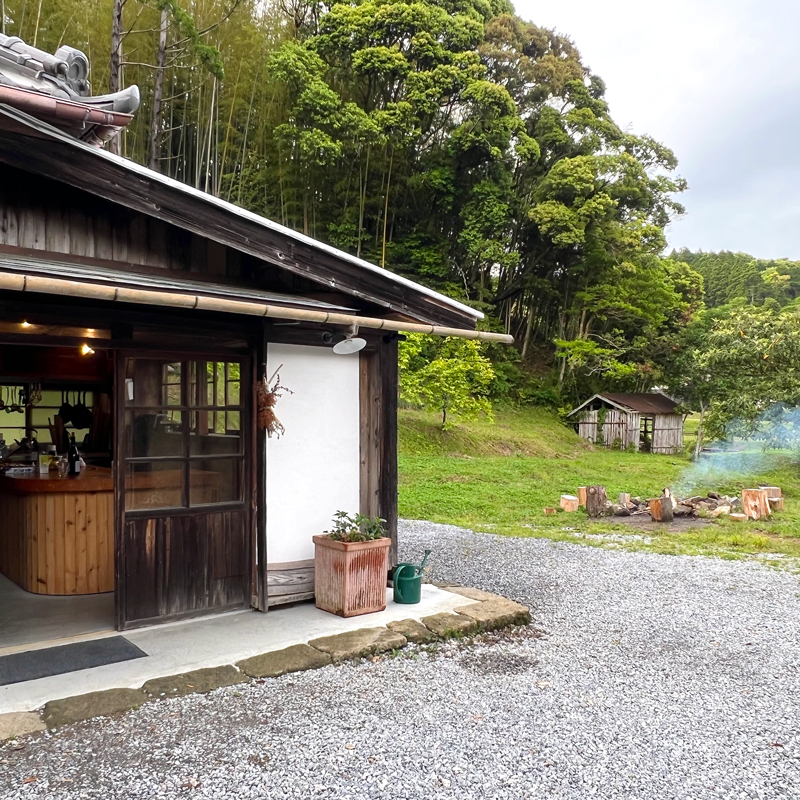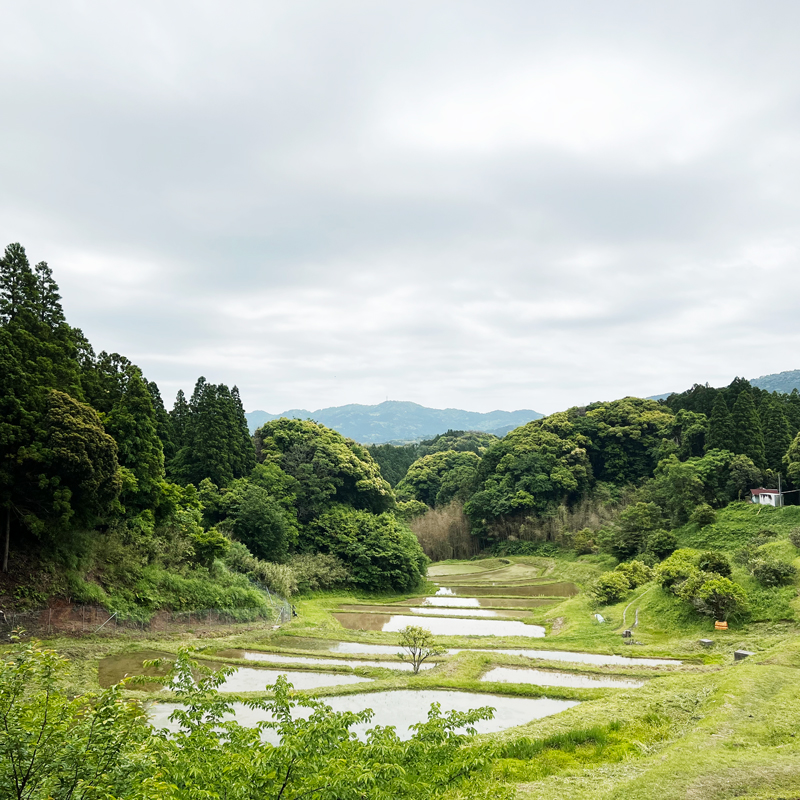#23
well-being / keeping / recycling
Old Folk House Shitasan
Small Earth
Kamogawa, Chiba, Japan
the product:
The old folk house “Shita-san" is located in the Kamanuma village of about 25 households in the mountains of Kamogawa, Chiba Prefecture. The village has a rich woodland and rain-fed paddy rice terraces, which is a beautiful land where the original scenery of Japan remains.
The house was originally belonged to a person who served as the village chief in the Taisho era(1912-1926) and there is a storehouse and a cowshed on the premises. There is a bamboo grove in the back of the house, and in front of the house, there are paddy fields.
The house had been lived in for generations, but it was damaged by Typhoon No.15 in 2019. At the same time, it was sold together with the woodland.
Afterwards, the old folk house has been reborn as a community space maintaining the style of the village chief’s house where people used to gather, and was named as “Shita-san”, retaining the trade name of the village chief.
Now the house is used not only for lodging, but also as a place where various people gather, such as cafes, corporate and university training, and events such as organic markets.
The renovation has started in 2021 and the students from the Tsukamoto Laboratory of the Tokyo Institute of Technology helped to carry out various construction work, such as dismantling and designing.
While maximizing the charm of the old folk house, it was carefully dismantled so that usable materials could be reused so as not to generate waste as much as possible. In addition, they use what is in the village to replace the missing items as much as possible, and are still gradually renovating the old folk house.
The renovation of the old folk house started in 2021. For renovation, they handled various construction work including dismantling and designing all by themselves with a cooperation of the students in the research lab of the university.
While maximizing the charm of the old folk house, they carefully dismantle the house so that usable materials could be reused so as not to generate waste as much as possible. They are renovating the house little by little using what is in the village as much as possible for what they need.
・Walls and Floors
The soil for the mud wall is made from the soil that came out when the trench for drainage was dug in the paddy rice terrace.
For the base of the mud wall, they put bamboos woven into a thin lattice, which are taken from the bamboo grove in the mountains behind. The mud walls, finished with layers of paint, harmonize with the old telephone and electrical wiring, which were left intact.
・Dirt floor (Doma)
The original soil was removed from the large dirt floor and bamboo stakes were driven into the soil to improve the environment. They finished the floor with concrete mixed with charcoal and straw.
Then, a new large counter-type community kitchen and a wood stove were built to create a lounge space where everyone can gather.
The lampshades in the lounge are made of finely woven bamboo taken from the mountains behind the house, as is the base material for the walls.
・Bathroom
The extended bathroom has a large window facing the mountain behind the house, giving it a sense of openness. The outer walls are made of recycled cedar bark that was cut down for wild animal damage control.
A round Shigaraki-ware bathtub placed by the window stores heat moderately and warms the body.
・Outdoors
There is a large bonfire space in front of the paddy field and a BBQ space with a roof adjacent to the main house, so you can enjoy it regardless of the weather. The former cattle shed is now a storeroom, and the storehouse is now a gallery.
The functional facilities/equipment that were added during the renovation of the old folk house “Shita-san", fit in as if they had always been there.
Even now, the renovation work continues little by little so that the building and the surrounding environment can circulate and harmonize.
(...)
(-)
the maker:
Yoshiki Hayashi lives in a old folk house “Yugitsuka" in the same Kamanuma village as the old folk house “Shita-san".While pursuing nature and art, Hayashi traveled around the world, including the U.S., Asia, and Europe, and moved to this area in 1999, fell in love at first sight with the beautiful farm villages that still retain the original Japanese landscape, such as rain-fed paddy rice terraces, charcoal-making huts, mandarin orange fields, and old thatched houses. Since then, under the theme of “a beautiful village creates a beautiful earth" in this aging village, he has presided over diverse activities that connect people to people, people to nature, and the city to the countryside, such as establishing the Kamanuma North Terraced Rice Field Owner System, the MUJI Kamogawa Satoyama Trust, the Association for Natural Sake Made in the Rain-fed Terraced Rice Field, the Kamanuma Charcoal Producers Association, the local currency Awamane, and university and business trainings. His entire activity is called “Sculpture of Life”.
After the Typhoon No. 15 disaster in 2019, he established a general incorporated association, Small Earth,
and started activities to make the entire Satoyama area, including old folk houses and terraced rice fields, a common property (commons) of society.
・Local Currency “Awa money"
In 2002, he introduces “awa money," a community local currency that can be used in the Awa region of southern Chiba Prefecture.
The system is like a passbook that can be used like money or barter, with 1awa = 1 yen, and is a mechanism for people living in the community to help each other in any way they can.
・Kamanuma North Terraced Rice Field Owner System
Since 2006, he has been inviting urban residents to become owners of terraced rice field to let the owners come to cultivate every month to preserve the rice in the field, that have become unmanageable due to the aging of the population.
Through this activity, local residents, new residents, and urban residents are connected, fostering a community that transcends the boundaries between the city and the countryside.
・NPO Uzu
The NPO Uzu, run by Hayashi, has been conducting the “Kamogawa Satoyama Trust" activities with the MUJI Institute for Quality Life since 2014. The activities are aimed at preserving Satoyama through Japanese food culture and handicrafts, including rice cultivation in the rain-fed terraced rice fields and making shimenawa ornaments out of harvested rice straw.
MUJI also built a terraced office right above the rain-fed terraced rice field, which is being preserved by the Kamogawa Satoyama Trust, as a symbol of a new way of working. It was designed by architect Yoshiharu Tsukamoto (Atelier Bow-Wow/Professor at Tokyo Institute of Technology).
・Thatch Restoration
In the fall of 2019, Typhoon No.15 hit Kamanuma village and blew off all the tin sheets covering the thatched roof of Hayashi's old house, Yugitsuka. Hayashi is fascinated by the beauty of the thatched roof, which was hidden by the tin sheets, and decides to restore the thatched roof.
In the past, Kamanuma village had a shared thatch farm where the material for thatch was grown.
And each year, new thatch was thatched on each house in the village in turn, thus circulating in the community.
However, due to depopulation, there is no more thatch field, common land, or communal work, which made thatched roofs became unsustainable and now become very expensive.
Hayashi began by clearing abandoned farmland to create thatch fields to grow silver grass, the material for thatched roofs.
To restore thatch, he created a "new association" and holds thatching camps every year to learn knowledge and skills from craftsmen, and replacing thatched roofs as a camp project.
・General Incorporated Association Small Earth
In 2019, as restoration work continues on his typhoon-damaged home, the traditional folk house “Shita-san”, also damaged by the typhoon, was put up for sale at the same time.
Hayashi decided to purchase the house jointly in order to ensure that it will not be lost to a single generation, but will be firmly connected to the future.
He has invited those who sympathize with his past activities for invest in the joint purchase and established the General Incorporated Association “Small Earth" through the joint purchase and operation of an old private house "Shita-san.
In addition to the old folk house “Shita-san," “Small Earth" works with city people to maintain the Satoyama environment by mowing the grass in winter, cultivating abandoned fields, and cutting down trees around electric fences to prevent damage from animals.
They sometimes hold lectures and workshops by carpenters, landscape architects, and other specialists to share various knowledge and skills with many people, such as adjusting doors and windows, improving the underground environment, and thatching, in an effort to create a sustainable cycle of life and society.
By combining the best aspects of nature, traditional culture and wisdom, and modern civilization, they are passing on a new culture to the next generation that will enrich the connection between people and nature. The revitalization of the Satoyama, which includes terraced rice fields and old folk houses that have been preserved for 1,000 years,
has spread to urban residents including businesses, universities, and NPOs, making the Satoyama of Kamanuma a “home for everyone" beyond geographical and blood ties.
small-earth.org
(...)
(-)




